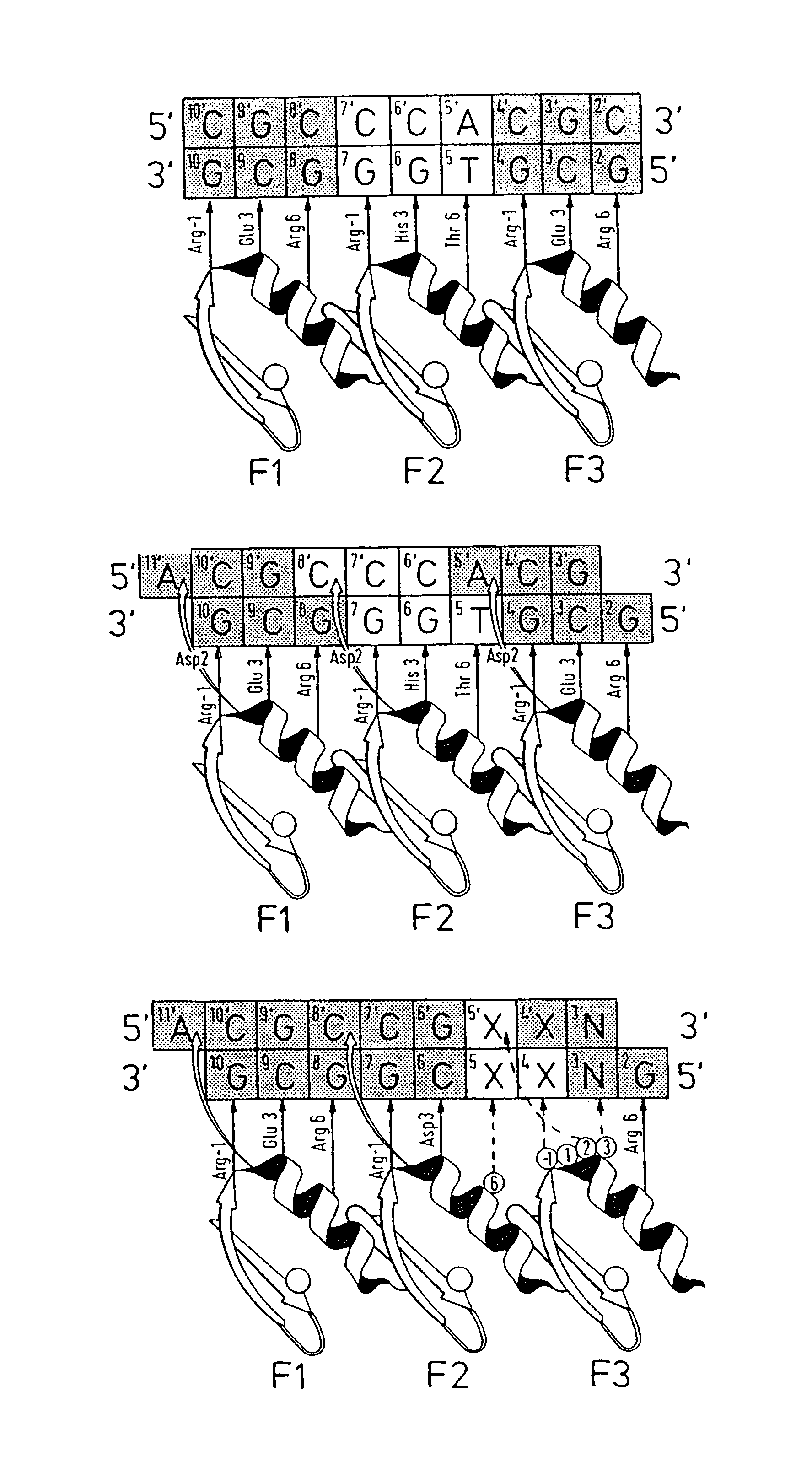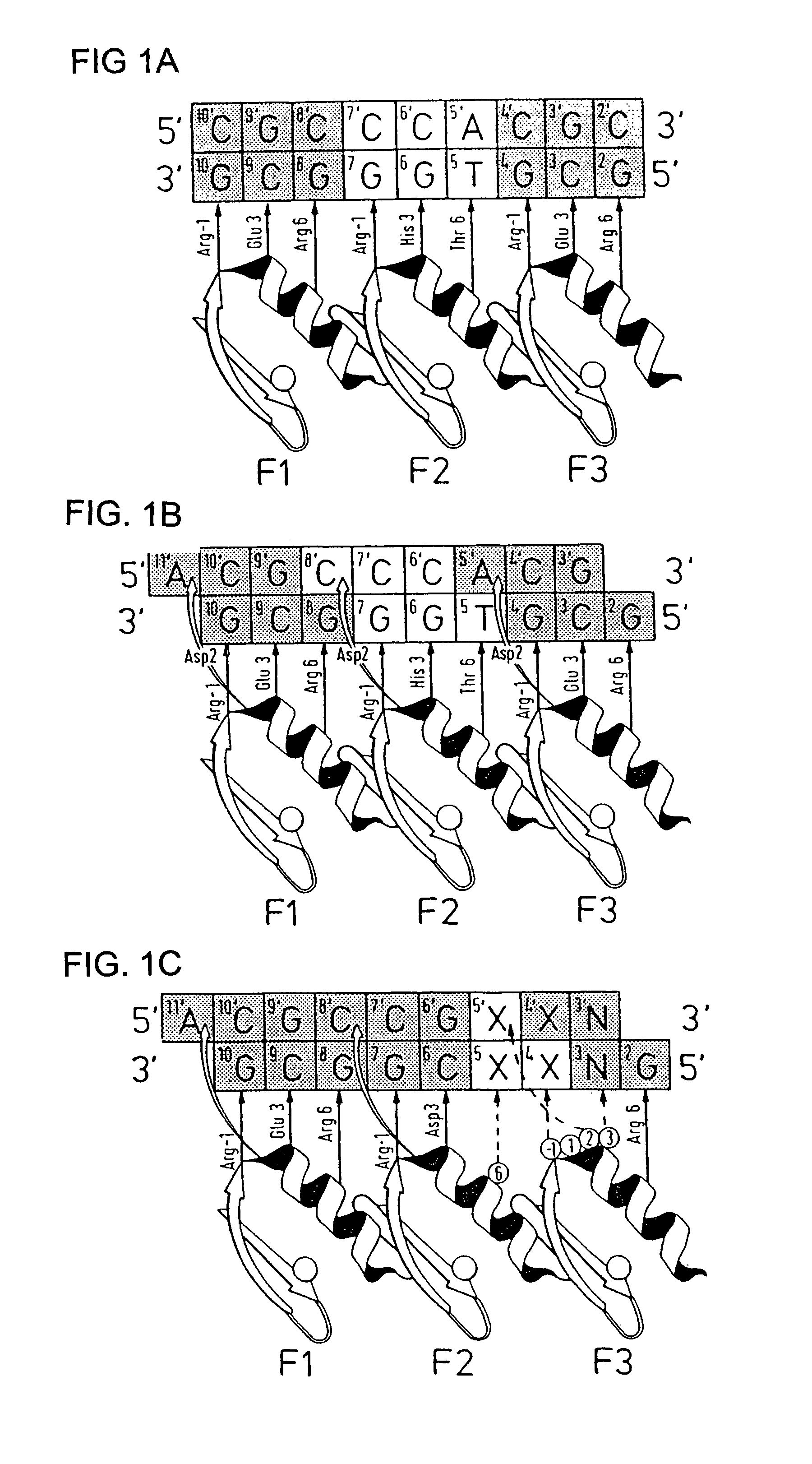Nucleic acid binding proteins
a technology proteins, applied in the field of nucleic acid binding proteins, can solve the problems of not finding a code which can describe dna recognition by all dna-binding proteins, the majority of known dna-binding motifs are not particularly versatile, and have not been found
- Summary
- Abstract
- Description
- Claims
- Application Information
AI Technical Summary
Benefits of technology
Problems solved by technology
Method used
Image
Examples
example 1
Determination of Binding Site Preferences in Zinc Fingers
Design of Zinc Finger Phage Display Libraries
[0142]Zinc finger-DNA recognition at the interface between adjacent DNA subsites is studied using a zinc finger phage display library. This library is based on the three-finger DNA-binding domain of Zif268, but contains randomisations of amino acids from finger 2 (F2) and finger 3 (F3), at residue positions which could form a network of contacts across the interface of their DNA subsites. The detailed design of the library is shown in FIG. 1c, together with the generic DNA binding site used in selections. Briefly, the library contains randomisations at F2 residue position 6 (hereafter denoted F2[+6]) and F3 residue positions −1, +1, +2 and +3 (hereafter denoted F3[−1], F3[+2], etc.).
[0143]Library selections are carried out using DNA binding sites that resembled the Zif268 operator, but which contained systematic combinations of bases in the DNA doublet which forms the base-step betw...
example 2
Determination of +2 Specificity for Position 1
[0155]The amino acid present in α-helical position 2 of a zinc finger can help determine the specificity for the base-pair at the interface of two overlapping DNA quadruplet subsites (see FIG. 1B; position 5 / 5′, corresponding to position 1 or 4 of the quadruplet as discussed above). An Asp residue present in F3[+2] of wild-type Zif268 has been shown to play a role in DNA recognition, and further examples are generated by the current phage display experiments (See Example 1 for details, and FIG. 5A).
[0156]The experimental protocol followed is that of Example 1. FIG. 5A shows an example of related zinc finger clones showing the effect of α-helical position 2 on DNA-binding specificity. In this case, position 6 of finger 2 is invariant (Asn) and the change in case specificity in the zinc finger in order to select for contact to this base is dictated by position +2 in finger 3.
[0157]This family of zinc fingers is derived from selections usin...
example 3
Construction of a Zinc Finger Protein
[0160]The target selected for the zinc finger nucleic acid binding protein is the activating point mutation of the human EJ bladder carcinoma ras oncogene, which was the first DNA lesion reported to confer transforming properties on a cellular proto-oncogene. Since the original discovery, ras gene mutations have been found to occur at high frequencies in a variety of human cancers and are established targets for the diagnosis of oncogenesis at early stages of tumour growth.
[0161]The EJ bladder carcinoma mutation is a single nucleotide change in codon 12 of H-ras, which results in a mutation from GGC to GTC at this position. A zinc finger peptide is designed to bind a 10 bp DNA site assigned in the noncoding strand of the mutant ras gene, such that three fingers contact ‘anticodons’ 10, 11 and 12 in series, as shown in FIG. 6, plus the 5′ preceding G (on the + strand of the DNA). The rationale of this assignment takes into account the fact that zi...
PUM
 Login to View More
Login to View More Abstract
Description
Claims
Application Information
 Login to View More
Login to View More - R&D
- Intellectual Property
- Life Sciences
- Materials
- Tech Scout
- Unparalleled Data Quality
- Higher Quality Content
- 60% Fewer Hallucinations
Browse by: Latest US Patents, China's latest patents, Technical Efficacy Thesaurus, Application Domain, Technology Topic, Popular Technical Reports.
© 2025 PatSnap. All rights reserved.Legal|Privacy policy|Modern Slavery Act Transparency Statement|Sitemap|About US| Contact US: help@patsnap.com



